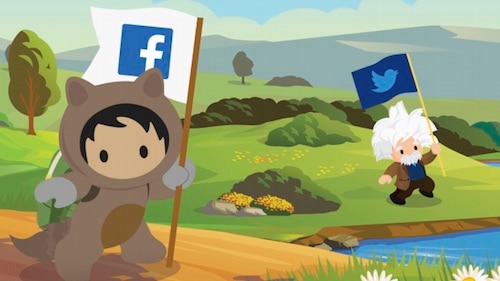A few years ago, most companies approached social media like it was the wild west. Like cowboys on a new frontier, newly-formed social teams worked in relative isolation, and social wasn’t a part of marketing platforms or considered integral to marketing strategy.
Now, this ‘wild west’ has been settled. Marketers know that social media — whether paid or organically published — can be valuable at every stage of the customer journey.
Ninety-three percent of the highest performing marketing teams have integrated marketing and advertising technology stacks, including social media.
Today, a customer can discover a product on Facebook and buy it later on Instagram. They can enter upsell journeys on Twitter, and engage in customer support chats on Messenger. They can even advocate for your products on forums or blogs!
Now marketers can deliver amazing social experiences — and those experiences are easier to deliver than ever before. With the August 2019 release of Social Studio, we’ve introduced the ability to boost Facebook posts directly within the platform, with all the approval rules, trust, and governance that companies need. Plus, Social Customer Service can conduct social service alongside all your other channels in Service Cloud, and Advertising Studio can manage all your social advertising at scale.
Many Trailblazers have already combined Social Studio and Advertising Studio to great effect. Here are their successful strategies:
1. Show them you care by showing them nothing
Not too long ago, I ordered a new pair of sneakers, but they didn’t fit. I wanted to return them, so I chatted with a customer service agent on Messenger — only to discover that the company’s return policy didn’t apply to the special edition sneakers I’d purchased. I ended up gifting the shoes to a friend but was so frustrated that I wanted to forget about the whole thing. Unfortunately, the brand wouldn’t let me.
Ads for the same exact pair of shoes followed me across Facebook and Instagram for the next few days, and I’d be lying if I said it didn’t bug me. I didn’t leave any angry comments or reactions but know some people in my situation might’ve, which would’ve been a bad look for the brand.
If the brand’s marketing, sales, and service had been properly integrated, this wouldn’t have happened. Social teams using Salesforce can effectively manage social communities by making sure that once people have sent queries to Social Customer Service, Advertising Studio suppresses ads to them. For even more intelligently-tailored results, you can also automatically suppress advertising based on different keywords, sentiments, or phrases in a customer’s social service query.
At difficult points in the customer journey, the best advertising may be no advertising. Customers may never know that you care about them enough to suppress ads during a frustrating time in their journeys, but in the long run, they’ll appreciate you for it.
2. Turn your communities into known customers
Community managers spend most of their time engaging with and responding to fans and followers across various social media platforms. Anyone who reaches out to your brand on social media has the potential to be a valuable customer. After all, they’ve shown a desire to interact with your brand! With the right responses, it’s entirely possible that you can inspire conversions and long-lasting customer relationships.
Social is the best way for brands to interact directly with customers in a shared space where people love to spend time. But remember, fans and followers are real people — they’re not data points owned by your business. By connecting social handles to customer accounts, marketers can understand the real person behind their social handles, and get to know their behaviors and preferences.
After you post content and boost it to your targeted demographics from within Social Studio, you can also develop a sweepstake or offer for social platforms like Facebook or Instagram. This tactic is particularly useful in converting unknown fans and followers into members of your known customer database. Lead generation ads can be managed by Advertising Studio, and submissions will be sent directly into Salesforce to easily connect your social advertising with the rest of the customer journey.
3. Listen a lot to learn a lot
Savvy marketers know that social listening lets you be a fly on the wall of customer conversations. It lets you lean in and see what people say about your brand, your competitors, and your industry at large. If you’ve never looked into social listening before, you’re in for a surprise — you can always uncover actionable insights out there.
With Social Studio’s industry-leading social listening capabilities, you can act on these insights and use them to inform your Advertising Studio creative. Listening can tell you the exact factors that drive positive sentiment and spikes in social conversation, which is impactful when used for real-time advertising during events. Listen right, and you can yield great results for your brand.
4. Listen up to build up your audience
You can also use listening to identify audiences on social platforms like Twitter. I once posted about a new reusable water bottle I’d purchased — I’d taken it on some hiking and kayaking trips and showed it off on social media. I didn’t expect this to happen, but the brand found me on Twitter and offered me 15% off my next purchase!
Using Social Studio, you can use a keyword search to identify people posting about your brand, and provide surprise-and-delight experiences just like the one I received from the water bottle brand. You can even deliver entire Advertising Studio campaigns to audiences found through social listening and invite them to
5. Use negativity to your advantage
Listening isn’t just for tracking how people feel about your brand. You can also listen to social sentiment from people who are shopping with competitors.
Imagine for a moment that you’re a marketer for a bank. More and more banks offer convenient digital services like mobile wallets. However, some have been slow to adopt this technology — and their customers are out there on social media complaining about it.
You can use Social Studio to identify these customers, then run campaigns targeting them with messages promoting your bank’s superior technology. To make sure you target customers in the right context, you can even filter ads by negative sentiment only.
Keywords and sentiment can also be used to target customers who shop around for a particular product or ask for advice. When you use the right keywords and capture customers early in the buying cycle with Social Studio, you’ll build even more effective audiences for Advertising Studio.
Want more inspiration for your customer experience strategy? Check out our Fifth Annual State of Marketing report.




























